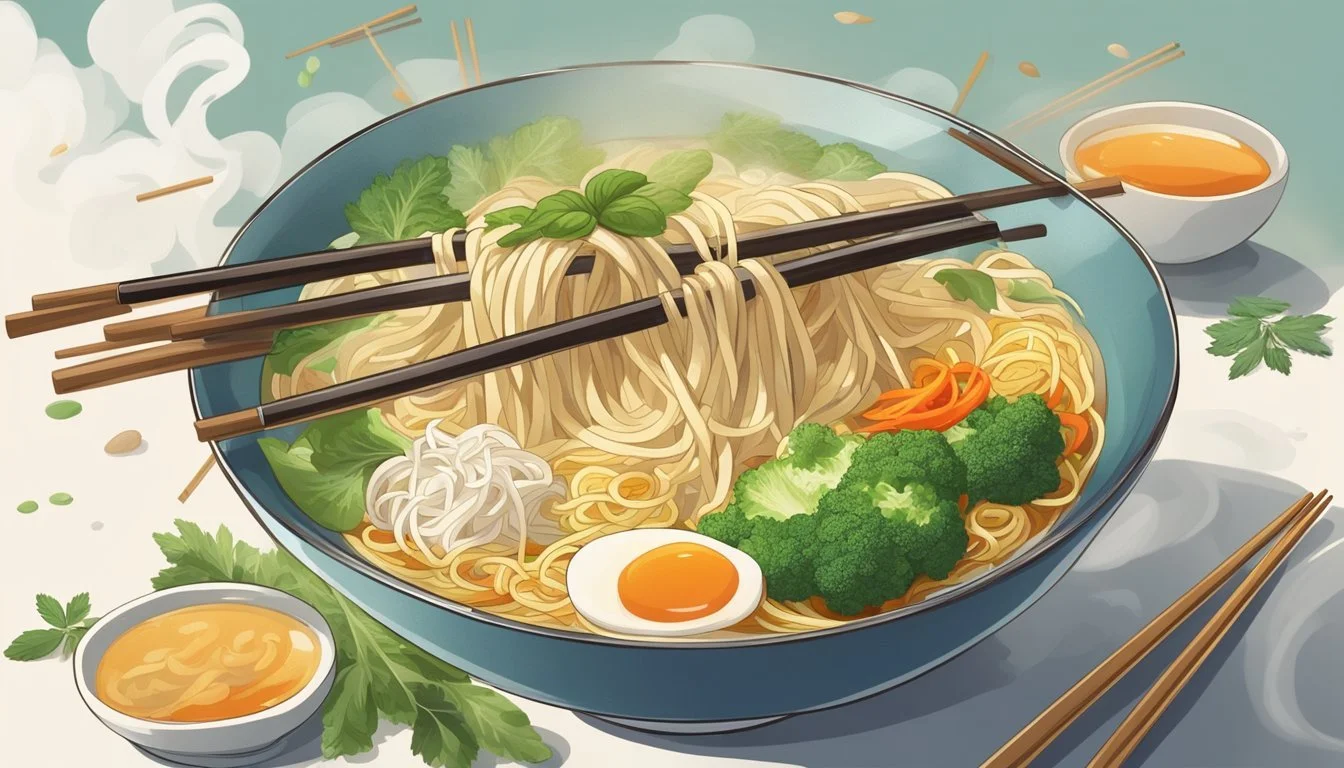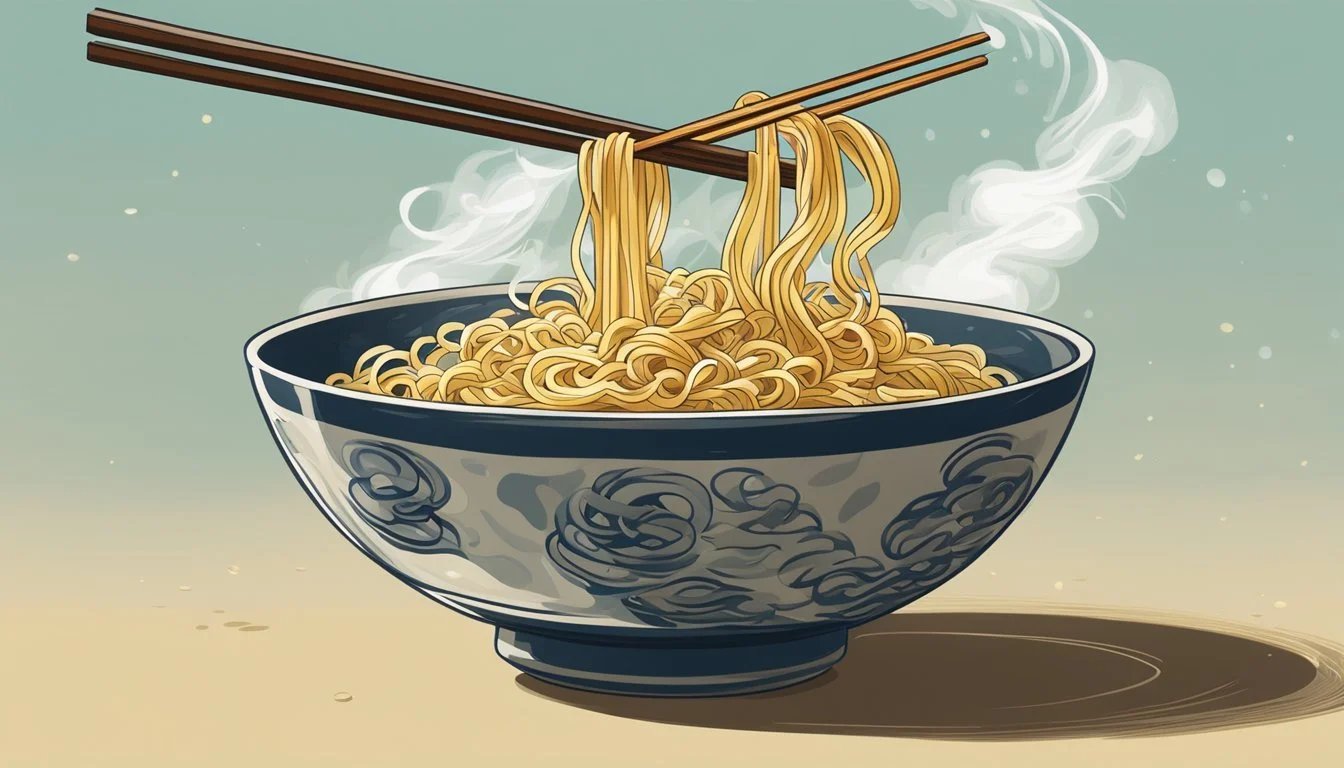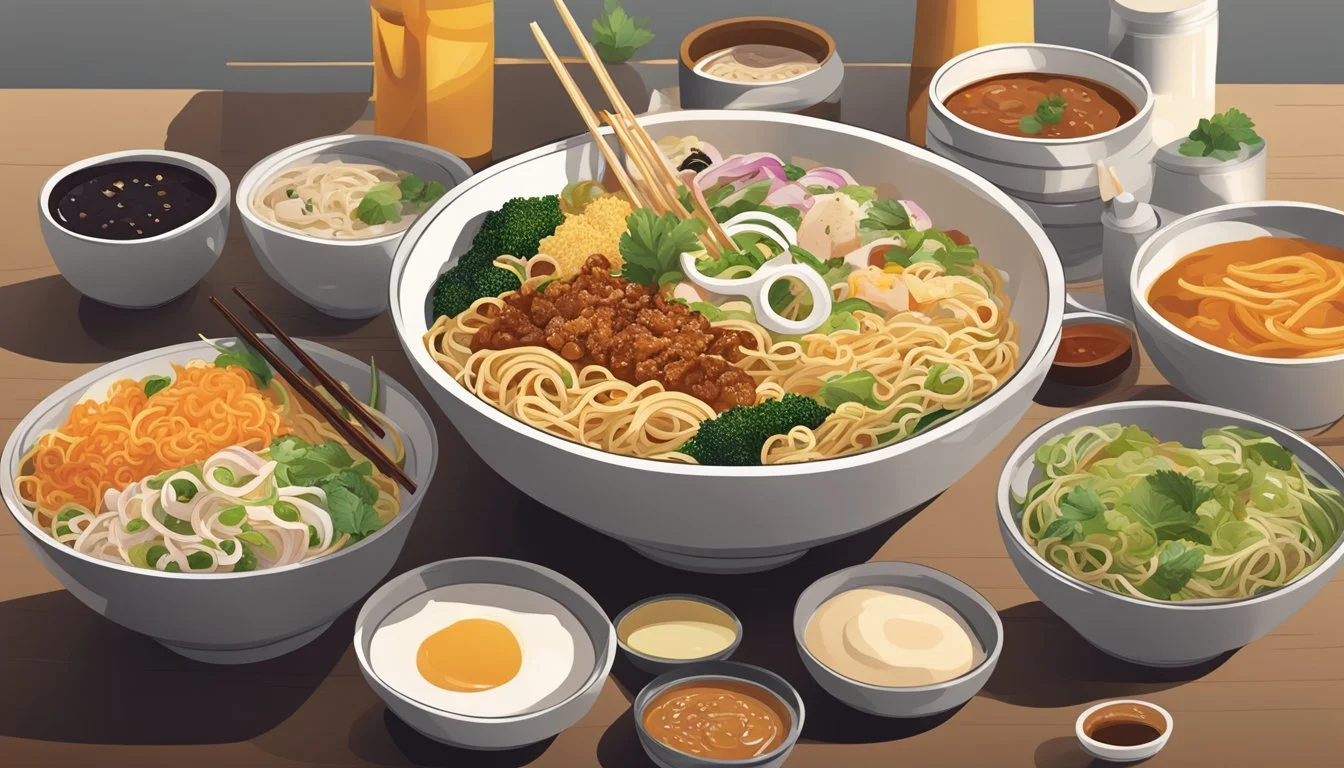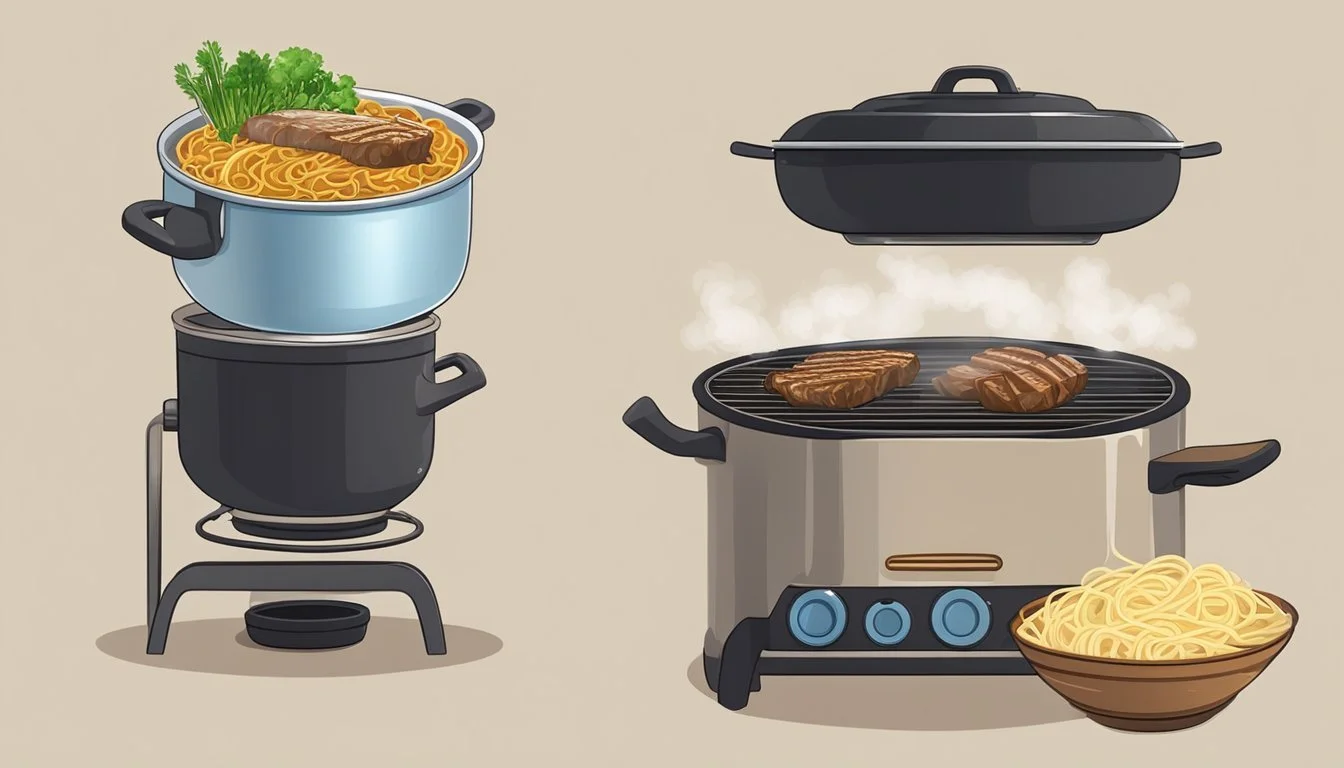How do you eat a noodle bowl?
Mastering the Art of Slurping and Savoring
Eating a noodle bowl is an art that combines flavor enjoyment with etiquette. Noodle bowls are versatile dishes found in various cuisines across the world, each offering a unique take on this staple food. Whether they are immersed in a savory broth or tossed in a rich sauce, noodles in a bowl are a comfort food enjoyed by many. They come with an assortment of toppings, such as meats, vegetables, and herbs, adding to their complexity and appeal.
To eat a noodle bowl, the diner often uses utensils best suited for the type and origin of the noodles being served. For instance, chopsticks are commonly used in East Asian countries, while forks or spoons may be more appropriate for Western-style pasta bowls. When dealing with long noodles, it is customary to twirl a manageable portion onto a fork, bringing it to the mouth without the strands dangling or falling back into the bowl.
Consumers appreciate the convenience of noodle bowls, as they encapsulate a well-rounded meal with protein, vegetables, and carbohydrates all in one single serving. This self-contained nature of a noodle bowl makes it an ideal choice for a quick yet wholesome meal that can satisfy a variety of dietary preferences and tastes. The proper way to consume a noodle bowl not only provides an enjoyable experience but also reflects respect for the dish's cultural origins.
Assembling Your Noodle Bowl
Crafting a well-assembled noodle bowl involves selecting quality ingredients that complement each other. One must carefully choose the right type of noodles, protein, and fresh vegetables and herbs to create a harmonious dish.
Choosing the Right Noodles
When selecting noodles for a noodle bowl, consider texture and dish type. Here's a quick guide:
Rice Noodles: Thin and delicate, perfect for lighter broths.
Vermicelli Noodles: Great in cold dishes or lighter, broth-based meals.
Soba: These buckwheat noodles offer a nutty flavor, suited to both hot and cold dishes.
Udon: Thick and chewy, ideal for hearty, rich soups.
Selecting Proteins
Protein is essential for adding substance to your noodle bowl. Choose based on dietary preference:
Chicken: A versatile option that pairs well with a variety of sauces.
Beef: Adds richness to the bowl; thinly slice for quick cooking.
Pork: Offers a savory depth, especially when grilled or roasted.
Tofu: A plant-based protein that absorbs flavors from the broth and sauces.
Shrimp or Fish: Seafood options that bring a light, fresh taste to the dish.
Preparing Vegetables and Herbs
Fresh vegetables and herbs are crucial for adding texture, color, and flavor. Incorporate a mix of:
Carrots and Cucumbers: Julienned for crunch and freshness.
Lettuce: Torn leaves add a refreshing crispness.
Bok Choy and Zucchini: Sauté lightly for a tender bite.
Fresh Herbs: (how long do fresh herbs last?) Cilantro, mint, and green onions offer a burst of flavor.
Ensure vegetables are cleaned and cut uniformly for even cooking and presentation. Fresh herbs should be added as a final touch to maintain their delicate flavors.
Crafting a Flavorful Broth
The foundation of a memorable noodle bowl lies in crafting a broth that is rich and full of depth. A successful broth balances the four basic flavor profiles: salty, sweet, sour, and umami, while layering aromatics and seasonings for complexity.
The Base of the Broth
The base starts with water which, upon simmering, extracts flavors from ingredients such as chicken thighs (What wine goes well with chicken thighs?) for their rich, hearty taste. A green element is brought in by adding bok choi or other leafy vegetables for a healthy, aromatic lift. For a traditional touch, Oriental components like garlic, ginger, and lemongrass introduce vibrant, pungent notes that create a foundational complexity, underpinning the eventual layers of seasoning.
Ingredients for Broth Base Quantity Water As needed Chicken thighs 500g Garlic 4 cloves Ginger 1-inch piece Lemongrass 1 stalk Bok choi 1-2 heads
Enhancing with Seasonings
To intensify the broth’s flavor, the judicious use of seasonings is critical. Salt anchors the broth’s taste, while sugar subtly counterbalances the salt’s intensity. An infusion of soy sauce adds umami depth, whereas fish sauce brings a distinctive, savory character typical of Southeast Asian cuisines. For a bit of heat, incorporate spicy elements like red pepper flakes. Lastly, fresh herbs like cilantro and basil (how long does basil last?) should be added in at the end of the cooking process to preserve their delicate flavors and to add a fresh, aromatic finish to the broth.
Soy sauce: Enhances umami and adds a rich color.
Fish sauce: Contributes a pungent, salty complexity.
Cilantro and basil: Offer a fragrant, herbaceous touch.
Salt and sugar: Balance seasoning levels.
Spicy ingredients (optional): Add heat to taste with red pepper flakes or fresh chilies.
By carefully building the base and thoughtfully enhancing with seasonings, one can create a broth that not only supports the rest of the noodle bowl ingredients but also stands out with its robust and harmonious flavor profile.
Expert Techniques for Cooking Noodles
Cooking noodles might seem straightforward, but employing expert techniques can elevate the dish. Noodles require sufficient space and water to cook uniformly, so one must start with a large pot filled with plenty of water. The ratio of water to noodles is essential; a good rule is to use 4-6 quarts of water for every pound of noodles.
Bringing the water to a rolling boil is a critical step. Once the water is boiling vigorously, one should add a generous pinch of salt. This seasons the noodles and can slightly raise the boiling point of the water, allowing the noodles to cook at a higher temperature.
When adding noodles to the pot, they should stir gently to avoid sticking. Timing is everything; noodles should be cooked according to the package instructions for the ideal texture, or al dente. Overcooking can lead to mushy noodles, while undercooking can result in an unpleasant crunch.
To test the doneness, they can remove a noodle and bite into it. It should be tender but still firm to the bite. Draining the noodles is best done promptly after cooking to stop the cooking process. However, one should reserve a bit of the pasta water. This starchy liquid can be used to adjust the sauce consistency later if needed.
Finally, they should add the noodles to the sauce as soon as possible to prevent clumping and to help the pasta absorb flavors. If the noodles need to wait, a little oil can be tossed with them to keep them from sticking.
Key Points:
Use a large pot with ample water to cook noodles.
Bring water to a full boil before adding noodles.
Season the water with salt for flavor.
Stir noodles to prevent sticking.
Cook to al dente and test for doneness.
Reserve pasta water for sauce adjustment.
Combine noodles and sauce promptly to avoid clumping.
Customizing with Sauces and Toppings
Noodle bowls offer a canvas for flavor experimentation, where sauces can enhance the taste with their sweet or tangy profiles, and a variety of toppings add not only texture but also layers of complexity to each bite.
Homemade vs. Store-bought Sauces
Sauces are the heart of a noodle bowl's flavor. A homemade sauce allows for tailored approaches to taste; it might be a sweet and tangy tamarind-based dressing or a spicy mix highlighting sriracha. Recipes often use a combination of soy sauce, fish sauce, or hoisin for depth. On the other hand, store-bought sauces offer convenience and consistent quality. Essentials such as teriyaki, peanut sauce, and nuoc cham can be sourced from local grocers, providing a quick way to infuse the dish with authentic flavors.
Variety of Toppings
The choice of toppings can transform the dish's texture and flavor profile:
Green onions and lime wedges contribute to the fresh, citrusy aroma.
Chopped peanuts and sesame seeds introduce a satisfying crunch.
Red pepper flakes and bean sprouts add a kick of spice and subtle sweetness, respectively.
Toppings should be applied generously yet thoughtfully, keeping in mind that each element should complement the existing flavors while introducing new ones.
Cooking Methods for Proteins
The preparation of proteins for noodle bowls varies, depending on the type of protein and desired flavor profiles. Cooking techniques are tailored to enhance the natural textures while incorporating rich, savory, or delicate seasonings.
Meat Preparation
For chicken, marinating it in a lemongrass marinade imparts a fragrant, zesty flavor that pairs excellently with rice noodles. The chicken should be thinly sliced to allow full penetration of the marinade and then grilled or pan-fried.
Marinate: Minimum of 30 minutes, up to overnight for deeper flavor
Cook: Grill or pan-fry until thoroughly cooked and golden
Beef benefits from a hearty, rich marinade. Searing it quickly on high heat preserves tenderness and locks in flavor.
Marinate: Use bold spices and seasonings
Cook: High-heat sear for a short duration
Grilled pork should be seasoned with a balanced combination of sweet and savory marinade elements before cooking to achieve a caramelized outer layer.
Marinate: A mix of soy sauce, honey, and spices can be utilized
Cook: Grill until it's cooked through with a slightly charred exterior
Seafood and Plant-Based Options
Shrimp cooks quickly and can be seasoned with a light marinade or simply with salt and pepper to maintain its delicate flavor.
Season: Lightly with marinade or simple seasoning
Cook: Sautéed or grilled until pink and opaque
Salmon brings a heart-healthy protein option to noodle bowls, often requiring only minimal seasoning to highlight its natural richness.
Marinade (Optional): Simple, light marinade for added flavor
Cook: Grilled or pan-fried to medium or as preferred
For a vegetarian option, tofu is a versatile protein that absorbs flavors well, often used in combination with a healthy and flavorful marinade.
Marinade: Press tofu to remove excess moisture, then marinate with ingredients like soy sauce, lemongrass, or a spice blend
Cook: Bake or pan-sear until the exterior is crispy and golden
Serving and Enjoying Noodle Bowls
When preparing to serve a noodle bowl, the presentation should be neat and inviting. The noodles, often either soba or rice variants, are typically the base. They should be cooked to achieve a balance between tenderness and firmness. The vegetables, possibly including carrots, broccoli, and edamame beans, are added over or around the noodles. These should retain a vibrant color and a tender-crisp texture.
Sauces and toppings are key to flavor and can include anything from a simple soy sauce to a rich sesame or red curry paste dressing. These elements should be drizzled or spooned over the bowl ingredients, flavoring the dish without overpowering the individual components.
Eating utensils come into play as well. Chopsticks are traditionally used for noodle bowls, offering a way to enjoy the meal authentically. They allow for picking up noodles and vegetables with ease, while a spoon is often used in conjunction to scoop up broth or liquid ingredients. For those less comfortable with chopsticks, forks are an acceptable alternative.
Additionally, one might choose to dip ingredients into sauces provided on the side, allowing for a customizable eating experience. This encourages diners to mix flavors to their own preference.
A well-set table in the kitchen or dining area enhances the overall experience. It should provide ample space for the bowl, utensils, and accompanying condiments, ensuring that the enjoyment of the noodle bowl is both comfortable and unhurried.
Remember to savor each element of the noodle bowl, appreciating the harmony of flavors and textures that come together in this delectable dish.
Exploring Regional Noodle Dishes
Noodle bowls differ widely around the globe, each region infusing its trademark flavors and ingredients to create authentic and local dishes that reflect the culinary traditions of their cultures.
Vietnamese Pho and Vermicelli
Vietnamese cuisine is renowned for its Pho, a noodle soup with a flavorful broth, rice noodles, herbs, and usually chicken or beef. It is a staple in Vietnamese restaurants worldwide, often personalized with garnishes such as mint leaves, thai basil, and bean sprouts. The nuoc cham sauce, a mixture of fish sauce, lime, sugar, and water, accompanies another popular dish, the rice vermicelli noodle dish, known locally as Bun. Rice vermicelli noodles are typically topped with grilled meat, fresh herbs, and served with nuoc cham on the side.
Thai and Japanese Varieties
Thailand's contribution to the noodle bowl family is highlighted by Pad Thai, a stir-fried noodle dish combining rice noodles with ingredients such as eggs, tofu, tamarind pulp, fish sauce, dried shrimp, garlic or shallots, red chili pepper, and palm sugar, garnished with roasted peanuts and lime wedges. Additionally, Thai noodle bowls often incorporate vegetables and herbs like thai basil to bring out a symphony of flavors.
In Japan, noodle dishes are diverse and steeped in tradition. Ramen, a wheat noodle soup, is perhaps the most internationally known, famous for its rich, meaty broth and various toppings like sliced pork, nori, and scallions. Udon, thick wheat noodles, are known for their chewy texture, served in a simple broth called kakejiru. In contrast, soba noodles, made from buckwheat, offer a nuttier flavor and are served hot in a broth or cold with a dipping sauce, catering to different preferences across the seasons.
Nutritional Benefits of Noodle Bowls
Noodle bowls can be nutritious meal choices when they include a balance of vegetables, protein, and carbohydrates. They often serve as a versatile dish that can cater to a variety of dietary preferences and nutritional needs.
Vegetables: Noodle bowls are frequently loaded with an assortment of fresh vegetables, which can include broccoli, sweet peas, and carrots. These vegetables contribute essential vitamins and minerals to one's diet. Broccoli, for instance, is rich in vitamin C and K, and it offers fiber and antioxidants.
Proteins: Adding a source of protein, such as chicken or egg, to noodle bowls can help to create a more filling meal that supports muscle repair and growth. Chicken provides a lean source of protein and is typically low in fat, making it a healthy choice for many.
Whole Grains: Some noodle varieties, like soba, are made from buckwheat flour and are a good source of nutrients like thiamin and manganese. Buckwheat has been associated with potential benefits for blood glucose control, especially in individuals with diabetes.
Fiber: The incorporation of high-fiber ingredients like noodles made from buckwheat or vegetables like pak choi can enhance digestive health. Fiber is important for maintaining a healthy digestive system and can contribute to a feeling of fullness.
In summary, by carefully selecting ingredients, individuals can create a nutritious and wholesome noodle bowl that offers a range of health benefits while catering to taste preferences. Here's a simple breakdown of the nutrients that can be found in a well-composed noodle bowl:
Vegetables: Vitamins, minerals, and fiber
Proteins: Essential amino acids, muscle support
Whole Grains: Thiamin, manganese, glucose control benefits
Fiber: Digestive health, satiety
Tips for Meal Prepping and Storage
When one opts for meal prepping noodle bowls, it's paramount to consider storage and longevity to ensure the dish remains delectable upon serving. Here are strategic steps to achieve optimal results:
Organization:
Begin by cleaning and organizing the refrigerator, guaranteeing space for meal containers.
Containers should be spaced to allow for air circulation, which aids in keeping food fresh.
Storage Techniques:
Divide the components. Store sauces and broths separately to prevent noodles from becoming soggy.
For a stir-fry or skillet meal, cool them before refrigeration to avoid condensation, which can dampen the texture.
Containers:
Opt for airtight containers to store store-bought or homemade ingredients and leftovers. This preserves flavors and resists contamination.
Layering:
When assembling, start with heavier or moisture-resistant ingredients at the bottom, stacking lighter items on top.
Reheating:
Leftovers should be heated evenly, either in a microwave or back in a skillet, stirring frequently to restore the original texture of the dish.
Ingredient Storage Tip Reheat Method Noodles Store dry or cooked separately Skillet or Microwave Sauce Airtight container away from noodles Stir into dish when hot Vegetables Sealed, can be pre-cooked or raw Microwave, then add Protein (if any) Store separately, can be pre-cooked Skillet to maintain texture
By diligently applying these methods, the flavor and texture of a noodle bowl will remain as intended, whether enjoyed immediately or savored as a convenient and appetizing meal prep option.









